
|
Luxembourg Stamps
|

|
Luxembourg Stamps
|
| January 3 (December 31 advance sale) | Year 2000 Stamp Booklet |
| March 7 | Tourism -- Wasserbillig and Walferdange |
| March 7 | International Year of Mathematics |
| March 7 | Emperor Charles V (1500-1558) -- 500th Anniversary of Birth |
| March 31 | Grand Duke Jean -- Definitive (right profile) |
| March 31 | Musical Instruments I |
| May 9 | Robert Schuman Declaration -- 50th Anniversary |
| May 9 | Europa 2000 |
| May 9 | Ducks |
| May 9 | "From Town Gas to Natural Gas" |
| September 27 | Wenzel Tour and Vauban Tour |
| September 27 | Contemporary Art |
| September 27 | Metallurgy in Luxembourg |
| September 27 | Accession of Grand Duke Henri |
| December 5 | Musical Instruments II |
| December 5 | Drawings by Abbot Jean Bertels III (Charity Issue) |
| December 5 | Christmas 2000 |

These stamps were issued in a credit-card-size booklet of eight self-adhesive stamps (two blocks of four stamps each). Each stamp has a permanent value of "A" (European 0-20 gm letter rate), which at the time of issue was 16 LUF. The booklets sold for 120 LUF (8 LUF below face value).
The design is a graphical interpretation of the passing over to the year 2000 and is formed by four se-tenant stamps making up the complete image. The artwork is by the COMED agency of Luxembourg.

Wasserbillig is a large commercial center at the confluence of the Moselle and Sûre rivers and is the embarkation point for the Marie Astrid and other pleasure boats. This stamp shows the former station building for the Prince Henri railroad, now restored and used by the local government.
Walferdange is most famous for its castle built in 1825. It was turned into a royal residence under King-Grand Duke Guillaume II; later, Prince Henri, Lieutenant of King-Grand Duke Guillaume III, lived there from 1850 until his death in 1879, and it served as a summer residence for Grand Duke Adolphe. This stamp shows the main facade of the building which is now an educational institution.

The United Nations has declared 2000 to be the International Year of Mathematics.
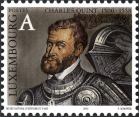
The great Emperor Charles V was born in Ghent in 1500. He was the eldest son of Philip the Fair, the Habsburg leader who also ruled the Burgundian realm that included Luxembourg and the Low Countries. His mother was Juana of Spain, daughter of the monarchs Ferdinand of Aragon and Isabella of Castile who are most famous to history for funding the voyages of Columbus to the New World.
Before the age of 20, Charles was to receive an incredible legacy. Upon his father's death in 1506 he inherited the Burgundian realm; in 1516, on the death of Ferdinand, he received the vast possessions of Spain, including Castile, Aragon, Sicily, Naples, the New World of America, and the Indies; and in 1519, upon the death of his grandfather Maximilian, he added the Habsburg territories (Bohemia, Hungary, and the Austrian duchies). In the end, Charles dominated all of central Europe, half of western Europe, and a good part of the New World.
Charles is known to Spain as King Carlos I but is better known to history as Emperor Charles V or Charles Quint. Under his rule, and the rule of his son and successor Philip II, Spain dominated Europe for most of the 16th century and accumulated incredible wealth by exploiting its possessions in North and South America.
Charles' accession marked the end of Burgundian rule in Luxembourg and the start of the period of Spanish domination that would last almost 200 years. Charles V, though technically a Burgundian, was molded by the influential court of Spain and it was this court's policies that steered Luxembourg through the 16th century and most of the 17th century.
Charles V abdicated in 1555 and died three years later.

This is a 9F value in the Grand Duke Jean definitive series that began in 1993. The portrait is by Pierre Schopfer of Switzerland.

This set of four stamps depicts popular musical instruments: the horn, the saxophone (invented by Adolphe Sax of nearby Dinant, Belgium), the violin, and the piano.

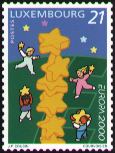



These stamps highlight two cultural tours that have been established in Luxembourg City.
The Wenzel Tour is named after Duke Wenceslas II (1346-1419); it was during his reign that walls were built around the Grund and the Rham Plateau. The tour encompasses the Bock, Stierchen Bridge, the Jacob Tower (shown on the stamp), and other vestiges of the old fortress found on the Rham Plateau.
The Vauban Tour is named after Sébastien le Prestre de Vauban, the great military architect to Louis XIV of France. Vauban was responsible for many buildings and fortifications that were constructed after a successful siege of Luxembourg by the French in 1684. The tour includes a visit to Vauban's Gate of the Bons-Malades, shown on the stamp.

These stamps show three works of abstract art owned by the Luxembourg P&T and painted by Luxembourg artists Joseph Probst (1911-1997), Will Kesseler (1899-1983), and Mett Hoffmann (1914-1993).

This stamp shows blast furnace "B" of the ARBED Esch-Belval steelworks. This furnace went into operation in 1970. With a crucible diameter of 9.2 m, a Paul Wurth engineered, "stopperless" type mouth and a daily capacity of 3,100 tonnes, it was one of the most efficient blast furnaces of its era. Its total production exceeded 20 million tonnes over its 27 year working life. It was overhauled in July/August 1993, ceased operation in August 1994, but was recommissioned on 23 January 1995. Blast furnace B was the last of its kind remaining in operation on Luxembourg soil until the end of 1997, the date of its final closure and the completion of the Luxembourg steel industry's conversion to the electricity grid.
The Esch-Belval site will become a prototype project in the conversion and renewal of industrial wasteland currently being planned by the state, local authorities, and ARBED. The idea is to create in the coming years not only a cultural site of industrial and archaeological interest, but also a "science, research and innovation park".
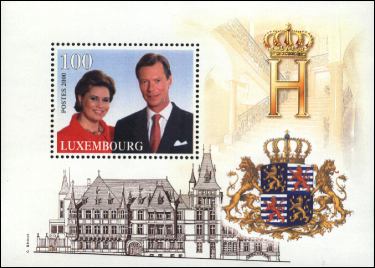
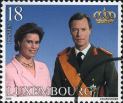
Grand Duke Henri became sovereign of Luxembourg on October 7, 2000 when his father, Grand Duke Jean, abdicated in his favor. Henri was born on April 16, 1955 and is married to Maria Teresa Mestre. The couple has five children, including Crown Prince Guillaume.

The electric guitar and the accordion are featured on these two definitive stamps.
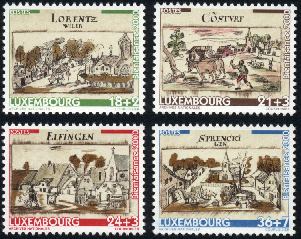
This set of stamps, the third in a series of three that began in 1998, depicts 16th century drawings of small Luxembourg towns by Abbot Jean Bertels (1544-1607). The drawings are from a collection of 88 known as the "Grand Bertels" that are kept in the National Archives of Luxembourg.
Bertels was born in Louvain, but came to Luxembourg at the age of 16 to be a monk at Münster Abbey. He was later to become the Abbot. In 1595 he was named Abbot of the prestigious Echternach Abbey by King Philip II and he served in that capacity until his death in 1607.
Bertels took a great interest in the culture and history of his adopted country. He expressed this interest not only through art, but also literature. He is recognized as the "first historian" of Luxembourg for his 1595 book, Historia Luxemburgensis.
This set of four stamps show 16th century scenes from the following towns:
Note that Jean Bertels himself was featured on a 1985 Luxembourg stamp.
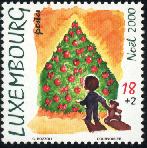
This stamp shows a young boy standing in front of an illuminated Christmas tree.